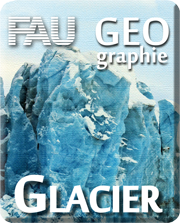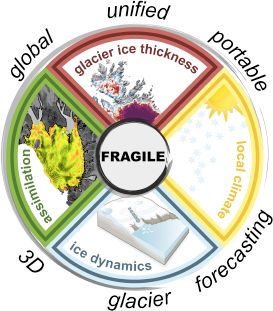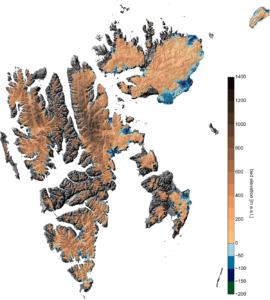NWG Gletschersysteme & Naturgefahren

Der weltweite Gletscherrückzug wird stets augenfälliger und der damit verbundene Eisverlust dominiert seit vielen Jahrzehnten den Beitrag zum Meeresspiegelanstieg. Das Interesse der AG Gletschersysteme & Naturgefahren ist daher die Prozesse, welche die Gletscherentwicklung in der Vergangenheit und der Zukunft steuern, zu verstehen und zu beschreiben.
Der erwartete Gletscherrückgang in der Zukunft erfordert zudem eine angemessene Abschätzung gletscherbedingter Risiken wie saisonale Wasserverfügbarkeit, Instabilität von Berghängen und zerstörerischen Schuttströmen nach Dammbrüchen von Gletscherseen. Angemessene Modellierungsstrategien erfordern daher eine ganzheitliche Betrachtung des Gletschersystems einschließlich hydrologischer, geomorphologischer und atmosphärischer Prozesse. Dies umfasst die Betrachtung von Prozessen wie Eisbergkalben, Schmelzwasserabfluss unter Gletschern, Abfließen von Schuttströmen sowie Isolationseffekte des darunterliegenden Permafrostes.
Die Nachwuchsgruppe (NWG) verfolgt ferner die Vision einer systematischen Nutzung der schnell wachsenden Informationen aus der Satellitenfernerkundung in geophysikalische Modellen. Auf diese Weise hoffen wir, unbekannte Parameter besser festlegen zu können, wie z.B. im Zusammenhang mit Reibung, Kalben oder dem Untergrundgelände. Letztendlich soll die Zuverlässlichkeit in Simulationen der Gletscherentwicklung für die Vergangenheit und die Zukunft verbessert werden. Die Anwendungen reichen dabei von einzelnen Gletschern über regionale Studien bis hin zu Eisschildern.
Kurz gesagt, wir sind freundliche und eisliebende Wissenschaftler*innen.
2023 Field Expedition – Cordillera Darwin
Jorge Berkhoff
- E-Mail: jorge.berkhoff@fau.de
Oskar Herrmann
- E-Mail: oskar.herrmann@fau.de
Mamta K C
- E-Mail: mamta.kc@fau.de
Veena Prasad
- E-Mail: veena.prasad@fau.de
Thematisch
- Eisdynamische Entwicklung von Gletschern und Eisschilden
- Gletscheränderungen unter klimatischen Veränderungen
- Klimawandel und Meeresspiegelanstieg
- Gletscherbedingte Naturgefahren im Hochgebirge
Methodisch
- Systematische Datenassimilierung
- Numerische Vorhersageverfahren
- Big data
IMMINENT – Der Einfluss des Klimas auf den jüngsten Gletscherrückgang in der Cordillera Darwin, Feuerland
Das Eisfeld der Cordillera Darwin (CDI) in Feuerland ist das drittgrößte Eisfeld der südlichen Hemisphäre und speichert etwa die doppelte Eismenge der europäischen Alpen. Generell beobachten wir dort in den letzten Jahren kontinuierliche Dickenabhname und Gletscherrückgang. Einzelne Gletscher weichen allerdings von diesem Trend ab. Es ergibt sich ein Bild mit stärkeren Verlusten im nördlichen Teil des CDI und stabileren Bedingungen oder sogar Zuwachs und Vorstößen im zentralen und südlichen Teil. Sowohl klimatische als auch eisdynamische Faktoren sind mögliche Erklärungen. Erstere werden durch Energie- und Massenflüsse an der Gletscheroberfläche bestimmt. Letztere eisdynamische Faktoren umfassen Massenverluste an den Eisfronten von Gletschern, die im Meer oder in Seen enden – auch frontale Ablation genannt. Mehr als die Hälfte der Gletscher des CDI münden direkt in proglazialen Seen oder in Fjorden. Eine verlässliche Zuordnung des Gesamtmassenverlustes zu diesen beiden Einflussfaktoren ist bisher nicht möglich, da die Region sowohl klimatologisch als auch glaziologisch kaum erforscht ist. Das Hauptziel dieses Projekts besteht nun darin den klimatischen Einfluss auf den Massenverlust der Gletscher des CDI in den letzten beiden Jahrzehnten zuverlässig zu bestimmen. Diese Bestimmung bietet eine einzigartige Gelegenheit, die Auswirkungen von Klimavariabilität und -wandel in diesen Breiten der südlichen Hemisphäre zu untersuchen.
Bei der geplanten Massenbudgetierung wird die klimatische Massenbilanz an der Gletscheroberfläche mit der Gesamtmassenänderung verglichen. Letztere lässt sich aus geodätischen Verfahren der Satellitenfernerkundung ableiten. Die Oberflächenmassenbilanz, die alle Massengewinne und -verluste an der Gletscheroberfläche umfasst, ist jedoch auf verlässliche Informationen der atmosphärischen Bedingungen angewiesen. Da klimatologischen Beobachtungsdaten in der Cordillera Darwin rar sind, planen wir eine Feldkampagne zu Beginn des Projekts, um jüngste Messdaten zu sichern. Um die Messreihen zu verlängern, wird ein ‘Downscaling’ der atmosphärischen Variablen durchgeführt. Besondere Aufmerksamkeit wird dabei dem Niederschlag und orografischen Effekten über dem Gebirge gewidmet. Die ganzjährig vorherrschenden Westwinde bewirken in dieser Region erhebliche Schneedrift, die die räumliche Heterogenität der Schneeablagerung erhöht. Dieser Prozess wird in einem physikalisch basierten Modell, welches die Energiebilanz an der Oberfläche und die Entwicklung der Schneedecke simuliert, berücksichtigt. Klima- und Modelldaten werden systematische mit den verfügbaren Beobachtungsdaten validiert. Die Simulationen am CDI in den letzten zwei Jahrzehnten ermöglichen es uns dann, die räumlichen und zeitlichen Variationen der Oberflächenmassenbilanz zu analysieren. Durch eine abschließende Massenbilanzierung werden wir eine erste Schätzung der frontalen Ablation und damit der eisdynamischen Kontrolle der Gletscherveränderungen ableiten.
Deutsche Forschungsgemeinschaft (DFG) – Project ID: 431767937![]()
Laufzeit: 2025-2028
Projekt-Team: Franziska Temme, Johannes Fürst
RESPONSE – Regionale Eisflussmodellierung in Patagonien bis zurück zur Kleinen Eiszeit
Die Eisfelder Patagoniens haben seit dem Ende der Kleinen Eiszeit (um 1870) an Masse verloren. Beobachtungen zeigen, dass sich dieser Massenverlust in den letzten Jahrzehnten stark beschleunigt hat. Im Gegensatz zum Massenverlust ergaben Modellrechnungen positive Werte für die klimatische Oberflächenmassenbilanz sowohl des nördlichen als auch des südlichen patagonischen Eisfeldes. Diese Diskrepanz kann durch dynamische Massenverluste an den Eisfronten von Auslassgletschern, welche direkt ins Meer oder in Seen münden, geschlossen werden. Viele der prominenten Gletscher zeigten im letzten Jahrhundert Phasen von Beschleunigung und Rückzug. Auf regionalen Skalen ergibt sich allerdings ein heterogenes und asynchrones Bild dieser Rückzugsphasen. Die Bedeutung für den Gesamtmassenverlust ist bis heute unklar. Das Ziel dieses Projekts ist daher eine eisdynamische Modellierungsstrategie zu entwickeln, die den regionalen Kalbungsverlust von Eisfelder sowie die klimatische Oberflächenmassenbilanz seit der Kleinen Eiszeit angemessen erfasst. Zu diesem Zweck soll ein regionales Eisflussmodell in Patagonien angewendet werden. Schwerpunkt ist das Südliche Patagonische Eisfeld. Das Modell umfasst bereits eine angemessenen Beschreibung der Oberflächenmassbilanz. Darüber hinaus werden eine dezidierte Kalibrierung auf Fernerkundungsdaten sowie geeignete Ansätze zur Beschreibung submarinen Schmelzens und Eisbergkalbens für die dortigen langgestreckten Auslassgletscher angestrebt. Mitthilfe von Klimareanalysedaten der letzten 150 Jahre werden wir die Rückzugsgeschichte der Eisfelder nachvollziehen. Ein Hauptaugenmerk wird dabei die Aufschlüsselung des beschleunigten Massenverlustes in anthropogene Klimaeinflüsse sowie in eisdynamischen Veränderungen liegen. Überdies sollen Zukunftsprojektionen der Eisfeldentwicklung unter Klimaerwärmung Aufschluss über die Hauptursachen des zukünftigen Massenverlusts für das nächste Jahrhundert geben. Dieses Projekt ist gut vernetzt mit ergänzenden Forschungsaktivitäten in Patagonien mit Fokus auf umfangreicher glaziologischer und geodätischer Feldarbeit, verbesserten Abschätzungen von Eismächtigkeiten, lokaler und prozess-orientierter Gletschersystemmodellierung sowie Fernerkundungsanalysen. Nach erfolgreichem Abschluss diese Projekts steht uns ein modernes Modellwerkzeug für zuverlässige Abschätzungen der eisdynamischen Entwicklung in Patagonien für dieses Jahrhundert sowie für tausendjährigen Zeitskalen zur Verfügung.
Deutsche Forschungsgemeinschaft (DFG) – Project ID: 495516510![]()
Laufzeit: 2025-2028
Projekt-Team: Anna Zoeller, Johannes Fürst, Ilaria Tabone
ITERATE – Eismächtigkeiten, Fernerkundung und Sensitivitätsexperimente mittels eines eisdynamischen Modells für Hauptauslassgletscher des südlichen patagonischen Eisfledes
Das Projekt zielt auf ein verbessertes Prozessverständnis der Gletscheränderungen und ihrer Ursachen und Sensitivitäten gegenüber möglichen zukünftigen Änderungen ab. Um diese Ziele zu erreichen werden wir neue Daten erheben, unsere bestehenden umfangreichen bestände aktualisieren und erweitern sowie die Informationen in eisdynamischen Modell für einzelne Gletscher zusammenführen und hier unterschiedliche Szenarien rechnen. Spezifisch werden wir zusätzliche Eisdickenmessungen vom Helikopter mit einem Eisdickenradar sowie flugzeuggestützte Laserscaning-Befliegungen durchführen. Die Feldmessungen werden in enger Kooperation mit unseren internationalen Kooperationspartnern durchgeführt. Wir werden unsere bestehenden Daten zu Gletscherfrontposition mittels optischer Satellitendaten zeitlich verdichten, Eisbewegungsfelder aus Sentnil-1 Radardaten mittels Offset-Trackings ableiten und verbesserte Gletscherhöhen- und Massenänderungen berechnen. Wir werden zudem eine state-of-the-art Eisdickenrekonstruktion unter Nutzung der Fernerkundungsprodukte durchführen. Durch die Einbeziehung umfangreicher Referenzdatensätze (neue und bestehende Eisdickenmessungen sowie bathymetrische Daten) werden wir eine deutlich verbesserte Güte gegenüber bestehenden Abschätzungen erzielen können. Wir werden hierfür unsere bestehende Routinen anpassen, um auch Eisdickendaten unterschiedlicher Qualität an einem Punkt gewichtet in die Rekonstruktion einfließen lassen zu können. Das letzte Arbeitspaket umfasst eine hochaufgelöste eisdynamische Modellierung einzelner Auslass-Gletscher, insb. der Perito Moreno, Upsala and Viedma Gletscher. Wir werden dabei insbesondere unterschiedliche in ELMER/Ice implementierte Kalbungsmechanismen sowie Sensitivitätsexperiemente gegenüber verschiedenen Parametern und Variablen testen. Dies umfassen Erhöhung des Eisuntergrundes, basale Reibung, Seespiegel-Variationen, Kalbungs-Parameter sowie Frontal Ablation.
Deutsche Forschungsgemeinschaft (DFG) – Project ID: 465209701![]()
Laufzeit: 2021-2025
Projekt-Team: Moritz Koch, Johannes Fürst, Matthias Braun
FRAGILE – Next generation framework for global glacier forecasting
Worldwide glacier retreat outside the two large ice sheets is increasingly tangible and the associated ice-loss has dominated the cryospheric contribution to sea-level change for many decades.  This retreat has also become symbolic for the effects of the generally warming climate. Despite the anticipated importance for future sea-level rise, continuing glacier retreat will affect seasonal freshwater availability and might add to regional water-stress in this century. Here, I envision a novel self-consistent, ice-dynamic forecasting framework for global glacier evolution that will lift the confidence in forward projections for this century to new heights. For the first time, each glacier on Earth will be treated as a three-dimension body within its surrounding topography without using any form of geometric simplification. The heart of the framework is the systematic utilisation of the rapidly growing body of information from satellite remote sensing. For this purpose, I intend to pass on to ensemble assimilation techniques that transiently consider measurements as they become available. This will streamline and increase the total information flow into glacier models. In terms of climatic forcing, global products will be replaced by regional forecasts with high-resolution climate models. Moreover, a more realistic representation of the local energy balance at the glacier surface is pursued that ensures multi-decadal stability in the melt formulation. The envisaged 3D finite-element modelling framework also allows a direct integration of iceberg calving, which is, on global scales, an oftenunconsidered dynamic ice-loss term. To this day, a key limitation of glacier projections is the poorly constrained ice volume and its distribution at present. Here, I put forward a promising remedy that builds on multi-temporal satellite information to calibrate a state-of-the-art reconstruction approach for mapping basinwide ice thickness on virtually any glacier.
This retreat has also become symbolic for the effects of the generally warming climate. Despite the anticipated importance for future sea-level rise, continuing glacier retreat will affect seasonal freshwater availability and might add to regional water-stress in this century. Here, I envision a novel self-consistent, ice-dynamic forecasting framework for global glacier evolution that will lift the confidence in forward projections for this century to new heights. For the first time, each glacier on Earth will be treated as a three-dimension body within its surrounding topography without using any form of geometric simplification. The heart of the framework is the systematic utilisation of the rapidly growing body of information from satellite remote sensing. For this purpose, I intend to pass on to ensemble assimilation techniques that transiently consider measurements as they become available. This will streamline and increase the total information flow into glacier models. In terms of climatic forcing, global products will be replaced by regional forecasts with high-resolution climate models. Moreover, a more realistic representation of the local energy balance at the glacier surface is pursued that ensures multi-decadal stability in the melt formulation. The envisaged 3D finite-element modelling framework also allows a direct integration of iceberg calving, which is, on global scales, an oftenunconsidered dynamic ice-loss term. To this day, a key limitation of glacier projections is the poorly constrained ice volume and its distribution at present. Here, I put forward a promising remedy that builds on multi-temporal satellite information to calibrate a state-of-the-art reconstruction approach for mapping basinwide ice thickness on virtually any glacier.
European Research Council (ERC) – Starting Grant
Period: 2021 – 2026
Project staff: Theresa Diener, Alexander R. Groos, Johannes Fürst
MAGIC – Das Vorhersageverfahren für Gebirgsgletscher
Bilder des weltweiten Gletscherrückgangs sind heutzutage ein greifbares Sinnbild für spürbare Konsequenzen der globalen Erwärmung. In unmittelbarer Zukunft erwarten wir, dass dieser Niedergang anhält und bedeutsam zum globalen Meeresspiegelanstieg beiträgt. Des Weiteren hat der globale Gletscherschwund Einfluss auf lokale Wasserverfügbarkeit und in einige Regionen ist die ganzjährige Versorgung gefährdet. Verlässlichere Vorhersagen des zukünftigen Eisrückgangs sind damit unerlässlich zur Abschätzung von sozioökonomischen Risiken und Auswirkungen. Das Hauptziel dieses Projekts ist daher die Schaffung eines einsetzbaren Modellierverfahrens, welches verlässliche Simulationen vergangener und zukünftiger Gletscherentwicklung erlaubt. Das Eisflussmodell Elmer/Ice wird als Grundlage zur Entwicklung dieses prozess-orientierten Verfahrens dienen. Die Zielstellung dabei ist es den Einfluss von drei wichtige Unsicherheitsquellen zu minimieren. Im Vorgriff auf die stetig wachsende Informationsmenge aus der Satellitenfernerkundung, werden wir robuste Datenassimilationsmethoden entwickeln, um die meist unbekannte Bodentopographie unter Gletschern verlässlicher zu bestimmen sowie Fließparameter besser zu kalibrieren. Diese Unbekannten legen den Anfangszustand für Vorhersagen fest und entscheiden über die Relevanz der Eisdynamik. Elmer/Ice soll zudem an ein verbessertes Modell für die Oberflächenmassenbilanz, d.h. der Differenz aus Schneeakkumulation und Schmelze, gekoppelt werden. Die Schmelzbeziehung des gewählten Modells soll für längeren Zeitskalen (Jahrzehnte) geeignet sein. Basierend auf Ensemble- Simulationen erlaubt dieser Modellierungsrahmen eine fundierte Quantifizierung eisdynamischer Wechselwirkungen sowie der Fortpflanzung von Anfangsunsicherheiten. Als Machbarkeitsstudie, wenden wir den angestrebten Modellierungsrahmen auf zwei gletscherbedeckte Gebiete in den französischen Alpen und der chilenischen Cordillera Darwin an. Diese Standorte wurden gewählt da in beiden Regionen der Einfluss der Eisdynamik bedeutsam ist und da Feldmessungen sowie Fernerkundungsdaten verfügbar sind. Beide Standorte sind zudem anspruchsvolle Testbeispiele um die Anwendbarkeit, Leistungsfähigkeit und Robustheit des Modellierungsrahmens unter verschiedenen klimatischen Bedingungen und dynamischen Gegebenheiten zu untersuchen.
Deutsche Forschungsgemeinschaft (DFG) – Project ID: 431767937![]()
Laufzeit: 2020-2023
Projekt-Team: Franziska Temme, Johannes Fürst, Fabien Gillet-Chaulet
Tapping the potential of Earth Observations (TAPE) – FAU Emerging Fields Initiative
Project staff: Thorsten Seehaus, Lukas Sochor, Matthias Braun, Johannes Fürst, Eberhard Bänsch, Andreas Maier, Nora Gourmelon
Ziel des Projekts ist es, die Zeitreihen von Erdbeobachtungs(EO)-Daten mit innovativen Methoden des „Deep Learnings“ zu analysieren, um effiziente Algorithmen zur Bewältigung der großen Datenmengen zu entwickeln. Der Wert dieser EO-Produkte wird durch fortgeschrittene Interpolationstechniken und Assimilation in geophysikalische Modelle, die es in der angewandten Mathematik gibt, weiter erhöht.
Funding period 2019-2022
Abgeschlossene Projekte
Im Laufe des vorigen Jahrhunderts betrug die globale Erwärmung an der Erdoberfläche ca. 0.7°C. Da das Klimasystem einen Verstärkungseffekt in hohen Breiten aufweist, war diese Erwärmung stärker ausgeprägt in der Polarregion. Eine Folgeerscheinung ist der allgemeine Rückgang der Gletscher auf Svalbard im vorigen Jahrhundert. In den letzten Jahrzehnten hat sich die Dickenabnahme im Süden allerdings dramatisch beschleunigt. Diese jüngste Entwicklung lässt sich jedoch nicht auf die gesamte Arktis übertragen, denn das Svalbard Archipel ist klimatisch  gesehen, besonderen Gegebenheiten unterworfen. Untypisch für diese Breiten, erfährt es ein eher warmes und wechselhaftes Klima. Aus diesem Grunde wird die Gletscherentwicklung auf Svalbard oft als Vorbote für bevorstehende Änderungen in den anderen arktischen Regionen gesehen.Im Vergleich zu anderen Teilen der Arktis sind auf Svalbard sowohl Gletscherausdehnungen und Geometrieänderung der letzten Jahrzehnte gut dokumentiert. Deren Interpretation mit Hinblick auf den Klimawandel ist allerdings behindert, da geometrische Veränderungen durch die klimatische Oberflächenmassenbilanz und Eisflussdivergenzen verursacht werden. Letztere sind bestimmt durch die Geometrie und den Eisfluss, wodurch sie nicht zwangsläufig direkt an klimatologische Veränderungen gekoppelt sind. Da es jedoch nur spärliche und meist asynchrone Geschwindgkeits- und Mächtigkeitsmessungen gibt, ist eine Quantifizierung des dynamischen Beitrags zu Gletscherveränderungen bis zum heutigen Tage weitestgehend unmöglich. Des Weiteren haben wir dadurch nur eine sehr vage Vorstellung des jährlichen Eisausflusses durch Eiskalben an den marinen Gletscherfronten. Dieser Eisausfluss erklärt vermutlich einen nicht unerheblichen Teil der jährlichen Eismassenbilanz des Archipels.Das Ziel dieses Forschungsantrags ist eine fundierte Bestimmung der dynamischen Komponente der Gletscherentwicklung auf Svalbard. Zu diesem Zweck werden flächendeckende Oberflächengeschwindigkeiten aus Fernerkundungsdaten abgeleitet, welche wiederum benötigt werden für eine Rekonstruktion der basalen Topographie unter der Eisdecke Svalbards.
gesehen, besonderen Gegebenheiten unterworfen. Untypisch für diese Breiten, erfährt es ein eher warmes und wechselhaftes Klima. Aus diesem Grunde wird die Gletscherentwicklung auf Svalbard oft als Vorbote für bevorstehende Änderungen in den anderen arktischen Regionen gesehen.Im Vergleich zu anderen Teilen der Arktis sind auf Svalbard sowohl Gletscherausdehnungen und Geometrieänderung der letzten Jahrzehnte gut dokumentiert. Deren Interpretation mit Hinblick auf den Klimawandel ist allerdings behindert, da geometrische Veränderungen durch die klimatische Oberflächenmassenbilanz und Eisflussdivergenzen verursacht werden. Letztere sind bestimmt durch die Geometrie und den Eisfluss, wodurch sie nicht zwangsläufig direkt an klimatologische Veränderungen gekoppelt sind. Da es jedoch nur spärliche und meist asynchrone Geschwindgkeits- und Mächtigkeitsmessungen gibt, ist eine Quantifizierung des dynamischen Beitrags zu Gletscherveränderungen bis zum heutigen Tage weitestgehend unmöglich. Des Weiteren haben wir dadurch nur eine sehr vage Vorstellung des jährlichen Eisausflusses durch Eiskalben an den marinen Gletscherfronten. Dieser Eisausfluss erklärt vermutlich einen nicht unerheblichen Teil der jährlichen Eismassenbilanz des Archipels.Das Ziel dieses Forschungsantrags ist eine fundierte Bestimmung der dynamischen Komponente der Gletscherentwicklung auf Svalbard. Zu diesem Zweck werden flächendeckende Oberflächengeschwindigkeiten aus Fernerkundungsdaten abgeleitet, welche wiederum benötigt werden für eine Rekonstruktion der basalen Topographie unter der Eisdecke Svalbards.
Die geplante Rekonstruktion bedient sich des fundamentalen Prinzips der Massenerhaltung, liefert damit eine strömungskonsistente Karte der Eismächtigkeiten und ist bereits verfügbar in unserem Eismodell. Die Rekonstruktion ermöglicht die Berechnung der Flussdivergenz und somit eine bessere Interpretation der jüngsten Veränderungen angesichts der aktuellen Erwärmung in der Arktis. Darüber hinaus, können bisherige Extrapolationversuche zur Abschätzung des Gesamteisvolumens und des Gesamteisausflusses auf Svalbard ersetzt werden durch diese physikalisch fundierte Rekonstruktion. Die abgeleitete Bodentopographie ist im Einklang mit dem Eisströmungsfeld und wird vielen Anwendungen von Eisflussmodellen zugute kommen. Mit unserem Flussmodell werden wir regionale Unterschiede in der Bedeutung basalen Gleitens auf den Gesamteisfluss ableiten.
Deutsche Forschungsgemeinschaft (DFG) – Projektnummer 274939856![]()
BACHELOR
- Assess the risk for outburst floods from El Morado Glacier (J. Fürst)
- Implementing tipping cascades following ‘Wunder et al.’ (J. Fürst)
- Literature overview of glacier changes in the Cordillera Darwin (F. Temme & J. Fürst)
- Thermische Charakterisierung und Entwicklung von Alpinen Gletschern – Alpen oder Svalbard (Literaturrecherche, J. Fürst)
- Literature overview of supraglacial lakes drainages in Greenland (I. Tabone)
MASTER
- Assessing the impact of föhn events on the glacier surface mass balance in Southern Patagonia, 2D modelling WRF/COSIPY (F. Temme, J. Fürst, T. Mölg)
- Svalbard reconstruction of glacier ice thickness – update (J. Fürst)
- Mapping debris thickness on alpine glaciers using drone-based thermography and geodesy (A. Groos)
- Combining drone-based mapping and numerical glacier modelling to evaluate the impact of moulins and runoff on ice dynamics at the Kanderfirn glacier, Swiss Alps (I. Tabone & A. Groos)
- Thermische Isolationswirkung von Gletschern auf Permafrost im Hochgebirge (J. Fürst)
- Modelling the effect of supraglacial debris on the surface mass balance of alpine glaciers (A. Groos)
2025
- Carrión, D., Berkhoff, J.A., Loriaux, T., Wilson, R., Rada, C., Ugalde, F., & Bravo, C. (2025). Evolution of glacial lakes in Southern Patagonian Icefield between 1986 and 2023. Frontiers in Earth Science, 13. https://doi.org/10.3389/feart.2025.1534451
DOI: 10.3389/feart.2025.1534451
BibTeX: Download - Herrmann, O., Groos, A.R., Tabone, I., Jouvet, G., & Fürst, J. (2025). A Kalman Filter-based Framework for Assimilating Remote Sensing Observations into a Surface Mass Balance Model. Annals of Glaciology. https://doi.org/10.1017/aog.2025.10020
DOI: 10.1017/aog.2025.10020
BibTeX: Download - Mizerit, I., Morabito, E.G., Bechis, F., Terrizzano, C.M., Groos, A.R., Rugel, G.,... Zech, R. (2025). Pleistocene glacial geomorphology and chronology of the Nahuel Huapi-Limay and Traful catchments, northern Patagonia. Geomorphology, 485, 109836. https://doi.org/10.1016/j.geomorph.2025.109836
DOI: 10.1016/j.geomorph.2025.109836
BibTeX: Download - Pfluger, F., Weber, S., Steinhauser, J., Zangerl, C., Fey, C., Fürst, J., & Krautblatter, M. (2025). Massive permafrost rock slide under a warming polythermal glacier deciphered through mechanical modeling (Bliggspitze, Austria). Earth Surface Dynamics, 13(1), 41-70. https://doi.org/10.5194/esurf-13-41-2025
DOI: 10.5194/esurf-13-41-2025
BibTeX: Download - Rojas-Castillo, I.J., Mazzorana, B., Iribarren-Anacona, P., Fonseca-Gallardo, D., Berkhoff, J.A., Durán, G., & Iroume, A. (2025). Hydro-morphological reconstruction of the Blanco River in the eruptive event 2008: Variables that influenced the change of the channel course in Chaitén, Chile. Journal of South American Earth Sciences, 156. https://doi.org/10.1016/j.jsames.2025.105412
DOI: 10.1016/j.jsames.2025.105412
BibTeX: Download - Shahateet, K., Fürst, J., Navarro, F., Seehaus, T., Farinotti, D., & Braun, M. (2025). A reconstruction of the ice thickness of the Antarctic Peninsula Ice Sheet north of 70° S. Cryosphere, 19(4), 1577-1597. https://doi.org/10.5194/tc-19-1577-2025
DOI: 10.5194/tc-19-1577-2025
BibTeX: Download - Temme, F., Sommer, C., Schaefer, M., Jaña, R., Arigony-Neto, J., Gonzalez, I.,... Fürst, J. (2025). Climate’s firm grip on glacier ablation in the Cordillera Darwin Icefield, Tierra del Fuego. Nature Communications, 16(1). https://doi.org/10.1038/s41467-025-57698-6
DOI: 10.1038/s41467-025-57698-6
BibTeX: Download - Tetzner, D.R., Thomas, E.R., Allen, C.S., McCulloch, R.D., Perren, B.B., McGuire, A.,... Miller, S. (2025). The First Firn Core From the Cordillera Darwin Icefield: Implications for Future Ice Core Research. Journal of Geophysical Research: Atmospheres, 130(12). https://doi.org/10.1029/2024JD043124
DOI: 10.1029/2024JD043124
BibTeX: Download
2024
- Blasco, J., Tabone, I., Moreno-Parada, D., Robinson, A., Alvarez-Solas, J., Pattyn, F., & Montoya, M. (2024). Antarctic tipping points triggered by the mid-Pliocene warm climate. Climate of the Past, 20(9), 1919-1938. https://doi.org/10.5194/cp-20-1919-2024
DOI: 10.5194/cp-20-1919-2024
BibTeX: Download - Fürst, J., Farías Barahona, D., Blindow, N., Casassa, G., Gacitúa, G., Koppes, M.,... Schaefer, M. (2024). The foundations of the Patagonian icefields. Communications Earth & Environment, 5(1). https://doi.org/10.1038/s43247-023-01193-7
DOI: 10.1038/s43247-023-01193-7
BibTeX: Download - Langhamer, L., Sauter, T., Temme, F., Werner, N., Heinze, F., Arigony-Neto, J.,... Schneider, C. (2024). Response of lacustrine glacier dynamics to atmospheric forcing in the cordillera darwin. Journal of Glaciology. https://doi.org/10.1017/jog.2024.14
DOI: 10.1017/jog.2024.14
BibTeX: Download - Messmer, J., & Groos, A.R. (2024). A low-cost and open-source approach for supraglacial debris thickness mapping using UAV-based infrared thermography. Cryosphere, 18, 719–746. https://doi.org/10.5194/tc-18-719-2024
DOI: 10.5194/tc-18-719-2024
URL: https://tc.copernicus.org/articles/18/719/2024/
BibTeX: Download
2023
- Cook, S., Gillet-Chaulet, F., & Fürst, J. (2023). Robust reconstruction of glacier beds using transient 2D assimilation with Stokes. Journal of Glaciology. https://doi.org/10.1017/jog.2023.26
DOI: 10.1017/jog.2023.26
BibTeX: Download - Herrmann, O., Gourmelon, N., Seehaus, T., Maier, A., Fürst, J., Braun, M., & Christlein, V. (2023). Out-of-the-box Calving Front Detection Method Using Deep Learning. Cryosphere, 17, 4957–4977. https://doi.org/10.5194/tc-17-4957-2023
DOI: 10.5194/tc-17-4957-2023
BibTeX: Download - Hofmann, F.M., Groos, A.R., Garcia Morabito, E., Struck, J., Gnägi, C., Scharf, A.,... Zech, R. (2023). A regional assessment of the deglaciation history of the Swiss Plateau based on newly obtained and re-evaluated Be-10 cosmic-ray exposure ages. Quaternary Science Advances, 13, 1-17. https://doi.org/10.1016/j.qsa.2023.100124
DOI: 10.1016/j.qsa.2023.100124
BibTeX: Download - Koch, M., Seehaus, T., Friedl, P., & Braun, M. (2023). Automated Detection of Glacier Surges from Sentinel-1 Surface Velocity Time Series-An Example from Svalbard. Remote Sensing, 15(6). https://doi.org/10.3390/rs15061545
DOI: 10.3390/rs15061545
BibTeX: Download - Shahateet, K., Navarro, F., Seehaus, T., Fürst, J., & Braun, M. (2023). Estimating ice discharge of the Antarctic Peninsula using different ice-thickness datasets. Annals of Glaciology, 1-12. https://doi.org/10.1017/aog.2023.67
DOI: 10.1017/aog.2023.67
BibTeX: Download - Sommer, C., Fürst, J., Huss, M., & Braun, M. (2023). Constraining regional glacier reconstructions using past ice thickness of deglaciating areas - a case study in the European Alps. Cryosphere, 17(6), 2285-2303. https://doi.org/10.5194/tc-17-2285-2023
DOI: 10.5194/tc-17-2285-2023
BibTeX: Download - Temme, F., Farías Barahona, D., Seehaus, T., Janã, R., Arigony-Neto, J., Gonzalez, I.,... Fürst, J. (2023). Strategies for regional modeling of surface mass balance at the Monte Sarmiento Massif, Tierra del Fuego. Cryosphere, 17(6), 2343--2365. https://doi.org/10.5194/tc-17-2343-2023
DOI: 10.5194/tc-17-2343-2023
URL: https://tc.copernicus.org/articles/17/2343/2023/
BibTeX: Download
2022
- Groos, A.R., Aeschbacher, R., Fischer, M., Kohler, N., Mayer, C., & Senn-Rist, A. (2022). Accuracy of UAV Photogrammetry in Glacial and Periglacial Alpine Terrain: A Comparison With Airborne and Terrestrial Datasets. Frontiers in Remote Sensing, 3, 1-16. https://doi.org/10.3389/frsen.2022.871994
DOI: 10.3389/frsen.2022.871994
BibTeX: Download - Groos, A.R., Niederhauser, J., Lemma, B., Fekadu, M., Zech, W., Haensel, F.,... Veit, H. (2022). An hourly ground temperature dataset for 16 high-elevation sites (3493–4377 m a.s.l.) in the Bale Mountains, Ethiopia (2017–2020). Earth System Science Data, 14, 1043-1062. https://doi.org/10.5194/essd-14-1043-2022
DOI: 10.5194/essd-14-1043-2022
BibTeX: Download
2021
- Diener, T., Sasgen, I., Agosta, C., Fürst, J., Braun, M., Konrad, H., & Fettweis, X. (2021). Acceleration of Dynamic Ice Loss in Antarctica From Satellite Gravimetry. Frontiers in Earth Science, 9. https://doi.org/10.3389/feart.2021.741789
DOI: 10.3389/feart.2021.741789
BibTeX: Download - Farinotti, D., Brinkerhoff, D.J., Fürst, J., Gantayat, P., Gillet-Chaulet, F., Huss, M.,... Andreassen, L.M. (2021). Results from the Ice Thickness Models Intercomparison eXperiment Phase 2 (ITMIX2). Frontiers in Earth Science, 8. https://doi.org/10.3389/feart.2020.571923
DOI: 10.3389/feart.2020.571923
BibTeX: Download - Groos, A.R., Akçar, N., Yesilyurt, S., Miehe, G., Vockenhuber, C., & Veit, H. (2021). Nonuniform late pleistocene glacier fluctuations in tropical Eastern Africa. Science Advances, 7(11). https://doi.org/10.1126/SCIADV.ABB6826
DOI: 10.1126/SCIADV.ABB6826
BibTeX: Download - Groos, A.R., Niederhauser, J., Wraase, L., Haensel, F., Nauss, T., Akçar, N., & Veit, H. (2021). The enigma of relict large sorted stone stripes in the tropical Ethiopian Highlands. Earth Surface Dynamics, 9(2), 145-166. https://doi.org/10.5194/esurf-9-145-2021
DOI: 10.5194/esurf-9-145-2021
BibTeX: Download - Van Tricht, L., Huybrechts, P., Van Breedam, J., Fürst, J., Rybak, O., Satylkanov, R.,... Malz, P. (2021). Measuring and inferring the ice thickness distribution of four glaciers in the Tien Shan, Kyrgyzstan. Journal of Glaciology, 67(262), 269-286. https://doi.org/10.1017/jog.2020.104
DOI: 10.1017/jog.2020.104
BibTeX: Download
2020
- Lippl, S., Blindow, N., Fürst, J., Marinsek, S., Seehaus, T., & Braun, M. (2020). Uncertainty Assessment of Ice Discharge Using GPR-Derived Ice Thickness from Gourdon Glacier, Antarctic Peninsula. Geosciences, 10, 12. https://doi.org/10.3390/geosciences10010012
DOI: 10.3390/geosciences10010012
URL: https://www.mdpi.com/2076-3263/10/1/12
BibTeX: Download - Stadelmann, C., Fürst, J., Mölg, T., & Braun, M. (2020). Brief communication: Glacier thickness reconstruction on Mt. Kilimanjaro. Cryosphere, 14(10), 3399-3406. https://doi.org/10.5194/tc-14-3399-2020
DOI: 10.5194/tc-14-3399-2020
BibTeX: Download - Temme, F., Turton, J., Mölg, T., & Sauter, T. (2020). Flow Regimes and Föhn Types Characterize the Local Climate of Southern Patagonia. Atmosphere, 11(9), 899. https://doi.org/10.3390/atmos11090899
DOI: 10.3390/atmos11090899
BibTeX: Download - Welty, E., Zemp, M., Navarro, F., Huss, M., Fürst, J., Gärtner-Roer, I.,... Li, H. (2020). Worldwide version-controlled database of glacier thickness observations. Earth System Science Data, 12(4), 3039-3055. https://doi.org/10.5194/essd-12-3039-2020
DOI: 10.5194/essd-12-3039-2020
BibTeX: Download
2019
- Benn, D.I., Jones, R.L., Luckman, A., Fürst, J., Hewitt, I., & Sommer, C. (2019). Mass and enthalpy budget evolution during the surge of a polythermal glacier: A test of theory. Journal of Glaciology. https://doi.org/10.1017/jog.2019.63
DOI: 10.1017/jog.2019.63
BibTeX: Download - Farinotti, D., Huss, M., Fürst, J., Landmann, J., Machguth, H., Maussion, F., & Pandit, A. (2019). A consensus estimate for the ice thickness distribution of all glaciers on Earth. Nature Geoscience, 12(3), 168-+. https://doi.org/10.1038/s41561-019-0300-3
DOI: 10.1038/s41561-019-0300-3
BibTeX: Download - Groos, A.R., Bertschinger, T., Kummer, C., Erlwein, S., Munz, L., & Philipp, A. (2019). The potential of low-cost UAVs and open-source photogrammetry software for high-resolution monitoring of alpine glaciers: A case study from the kanderfirn (Swiss Alps). Geosciences, 9(8), 1-22. https://doi.org/10.3390/geosciences9080356
DOI: 10.3390/geosciences9080356
BibTeX: Download - Ossendorf, G., Groos, A.R., Bromm, T., Tekelemariam, M.G., Glaser, B., Lesur, J.,... Miehe, G. (2019). Middle Stone Age foragers resided in high elevations of the glaciated Bale Mountains, Ethiopia. Science, 365(6453), 583-587. https://doi.org/10.1126/science.aaw8942
DOI: 10.1126/science.aaw8942
BibTeX: Download
2018
- Fürst, J., Navarro, F.J., Gillet-Chaulet, F., Huss, M., Moholdt, G., Fettweis, X.,... Braun, M. (2018). The ice‐free topography of Svalbard. Geophysical Research Letters, 45(21), 11760-11769. https://doi.org/10.1029/2018GL079734
DOI: 10.1029/2018GL079734
URL: https://agupubs.onlinelibrary.wiley.com/action/showCitFormats?doi=10.1029/2018GL079734
BibTeX: Download
2017
- Farinotti, D., Brinkerhoff, D., Clarke, G., Fürst, J., Frey, H., Gantayat, P.,... Andreassen, L. (2017). How accurate are estimates of glacier ice thickness? Results from ITMIX, the Ice Thickness Models Intercomparison eXperiment. Cryosphere. https://doi.org/10.5194/tc-11-949-2017
DOI: 10.5194/tc-11-949-2017
BibTeX: Download - Fürst, J., Gillet-Chaulet, F., Benham, T., Dowdeswell, J., Grabiec, M., Navarro, F.J.,... Braun, M. (2017). Application of a two-step approach for mapping ice thickness to various glacier types on Svalbard. Cryosphere, 11(5), 2003-2032. https://doi.org/10.5194/tc-11-2003-2017
DOI: 10.5194/tc-11-2003-2017
BibTeX: Download - Groos, A.R., Mayer, C., Smiraglia, C., Diolaiuti, G., & Lambrecht, A. (2017). A first attempt to model region-wide glacier surface mass balances in the Karakoram: findings and future challenges. Geografia Fisica E Dinamica Quaternaria, 40, 137-159. https://doi.org/10.4461/GFDQ.2017.40.10
DOI: 10.4461/GFDQ.2017.40.10
BibTeX: Download - Rankl, M., Fürst, J., Humbert, A., & Braun, M. (2017). Dynamic changes on the Wilkins Ice Shelf during the 2006-2009 retreat derived from satellite observations. Cryosphere, 11(3), 1199-1211. https://doi.org/10.5194/tc-11-1199-2017
DOI: 10.5194/tc-11-1199-2017
BibTeX: Download
2016
- Fürst, J., Durand, G., Gillet-Chaulet, F., Tavard, L., Rankl, M., Braun, M., & Gagliardini, O. (2016). The safety band of Antarctic ice shelves. Nature Climate Change, 6, 479-482. https://doi.org/10.1038/nclimate2912
DOI: 10.1038/nclimate2912
URL: http://www.nature.com/nclimate/journal/vaop/ncurrent/full/nclimate2912.html
BibTeX: Download
2015
- Fürst, J., Gillet-Chaulet, F., Merino, N., Tavard, L., Mouginot, J., Gourmelen, N., & Gagliardini, O. (2015). Assimilation of Antarctic velocity observations provides evidence for uncharted pinning points. Cryosphere, 9(4), 1427-1443. https://doi.org/10.5194/tc-9-1427-2015
DOI: 10.5194/tc-9-1427-2015
URL: https://www.the-cryosphere.net/9/1427/2015/
BibTeX: Download - Fürst, J., Goelzer, H., & Huybrechts, P. (2015). Ice-dynamic projections of the Greenland ice sheet in response to atmospheric and oceanic warming. Cryosphere, 9(3), 1039-1062. https://doi.org/10.5194/tc-9-1039-2015
DOI: 10.5194/tc-9-1039-2015
URL: https://www.the-cryosphere.net/9/1039/2015/
BibTeX: Download - Thies, B., Groos, A.R., Schulz, M., Li, C.-F., Chang, S.-C., & Bendix, J. (2015). Frequency of low clouds in taiwan retrieved from MODIS data and its relation to cloud forest occurrence. Remote Sensing, 7(10), 12986-13004. https://doi.org/10.3390/rs71012986
DOI: 10.3390/rs71012986
BibTeX: Download
2014
- Zekollari, H., Fürst, J., & Huybrechts, P. (2014). Modelling the evolution of Vadret da Morteratsch, Switzerland, since the Little Ice Age and into the future. Journal of Glaciology, 60(224), 1155-1168. https://doi.org/10.3189/2014JoG14J053
DOI: 10.3189/2014JoG14J053
BibTeX: Download
2013
- Fürst, J., Goelzer, H., & Huybrechts, P. (2013). Effect of higher-order stress gradients on the centennial mass evolution of the Greenland ice sheet. Cryosphere, 7(1), 183-199. https://doi.org/10.5194/tc-7-183-2013
DOI: 10.5194/tc-7-183-2013
URL: https://www.the-cryosphere.net/7/183/2013/tc-7-183-2013.html
BibTeX: Download - Goelzer, H., Fürst, J., Huybrechts, P., Nick, F., Andersen, M., Edwards, T.,... Shannon, S. (2013). Sensitivity of Greenland ice sheet projections to model formulations. Journal of Glaciology, 59(216), 733-749. https://doi.org/10.3189/2013JoG12J182
DOI: 10.3189/2013JoG12J182
BibTeX: Download - Pattyn, F., Perichon, L., Durand, G., Favier, L., Gagliardini, O., Hindmarsh, R.,... Wilkens, N. (2013). Grounding-line migration in plan-view marine ice-sheet models: results of the ice2sea MISMIP3d intercomparison. Journal of Glaciology, 59(215), 410-422. https://doi.org/10.3189/2013JoG12J129
DOI: 10.3189/2013JoG12J129
BibTeX: Download - Rybak, O., Fürst, J., & Huybrechts, P. (2013). Mathematical modeling of ice flow in the north-western Greenland and interpretation of deep drilling data at the NEEM camp. Lëd i Sneg (Ice & Snow), 53(1), 16-25. https://doi.org/10.15356/2076-6734-2013-1-16-25
DOI: 10.15356/2076-6734-2013-1-16-25
BibTeX: Download - Zekollari, H., Huybrechts, P., Fürst, J., Rybak, O., & Eisen, O. (2013). Calibration of a higher-order 3-D ice-flow model of the Morteratsch glacier complex, Engadin, Switzerland. Annals of Glaciology, 54(63), 343-351. https://doi.org/10.3189/2013AoG63A434
DOI: 10.3189/2013AoG63A434
URL: https://www.cambridge.org/core/journals/annals-of-glaciology/article/calibration-of-a-higherorder-3d-iceflow-model-of-the-morteratsch-glacier-complex-engadin-switzerland/28C64E31C01707F003138DEC6231E632
BibTeX: Download
2012
- Fürst, J., & Levermann, A. (2012). A minimal model for wind- and mixing-driven overturning: threshold behavior for both driving mechanisms. Climate Dynamics, 38(1-2), 239-260. https://doi.org/10.1007/s00382-011-1003-7
DOI: 10.1007/s00382-011-1003-7
URL: https://link.springer.com/article/10.1007/s00382-011-1003-7?LI=true
BibTeX: Download
2011
- Fürst, J., Rybak, O., Goelzer, H., De Smedt, B., de Groen, P., & Huybrechts, P. (2011). Improved convergence and stability properties in a three-dimensional higher-order ice sheet model. Geoscientific Model Development, 4(4), 1133-1149. https://doi.org/10.5194/gmd-4-1133-2011
DOI: 10.5194/gmd-4-1133-2011
URL: https://www.geosci-model-dev.net/4/1133/2011/gmd-4-1133-2011.html
BibTeX: Download
2010
- Levermann, A., & Fürst, J. (2010). Atlantic pycnocline theory scrutinized using a coupled climate model. Geophysical Research Letters, 37. https://doi.org/10.1029/2010GL044180
DOI: 10.1029/2010GL044180
URL: https://agupubs.onlinelibrary.wiley.com/doi/abs/10.1029/2010GL044180
BibTeX: Download









